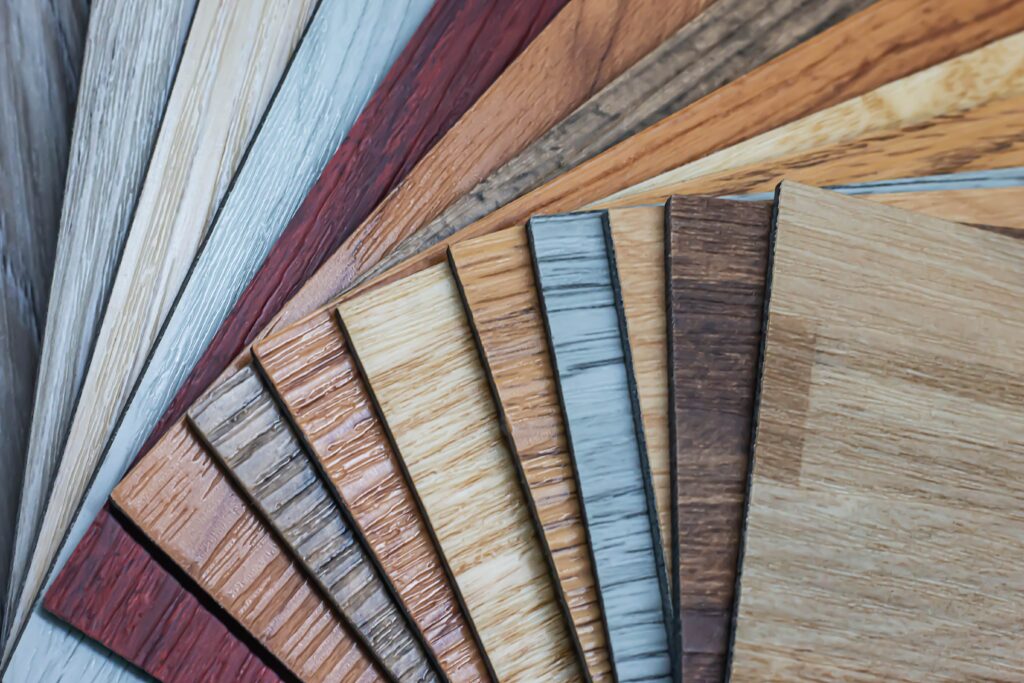You’ve made the decision that carpets, laminate, ceramic tiles and wood flooring is not for you, so that leaves you with vinyl flooring but you specifically want vinyl tiles or planks rather than vinyl rolls, but where do you even start making a choice given the bewildering array of brands, styles and specifications? In this article we will aim to shed some light on luxury vinyl tiles to help you make that all important choice.

What are Vinyl Tiles?
Back in the day everyone referred to these styles of flooring as Lino (short for linoleum) as this was essentially the first brand to make these “plastic” floor coverings, but modern vinyl floor coverings are a completely different animal. Vinyl flooring is made up of a series of layers: Starting at the bottom there is typically a backing layer which provides padding and sound proofing; on top of this comes the rigid core which provides rigidity to the flooring; The next layer is the PVC design layer, which can mimic wood or stone and finally there is the protective wear layer on top which provides durability. Modern vinyl tiles are more durable, more water resistant and more stain resistant than lino, making them a great choice for busy families with young children and pets.
What are Luxury Vinyl Tiles?
As with pretty much everything, there are levels of quality, but what sets LVTs apart from normal vinyl?
- Thickness and durability of the wear layer. Wear layers can range from 0.2mm to 1mm. Clearly the thicker the wear layer the more robust and durable the tiles will be. Bear in mind, though that you don’t need to go the to very thickest as these are designed for extremely high levels of footfall like schools and hospitals. For the average domestic property anything from the lowest 0.2m to 0.5mm would be just fine, with 0.5mm clearly being the better quality.
- The reality of the pattern on luxury vinyl tiles, due to its construction is much better than for standard vinyl.
- Luxury vinyl tiles are more rigid due to their core construction of either SPC (stone plastic composite) or WPC (wood plastic composite) and also tend to be thicker and more comfortable underfoot. Typically, LVT tiles are over 5mm thick and standard flooring is less than 4mm
What types of tiles are there?
There is a bewildering choice here which at its most basic is tiles and planks. Tiles are designed to resemble ceramic tiles and the patterns that they have and planks are designed to resemble wooden planks with all the grain and wood detail.
In terms of how these tiles are laid there are 4 options:
- Loose lay – these tiles have a grip backing which grips onto the floor holding the tile in place so it can’t move.
- Click-lock – This is very similar to the clock-lock system you will have seen with laminate or engineered wood floors. The tiles or planks simply lock into each other.
- Stick down – with these tiles, you need to apply glue to the floor and stick the tiles on top. This is a much more permanent installation technique.
- Self-adhesive – similar to the stick down, these tiles require glue to adhere to the floor, but they come with an adhesive layer already applied to the backing layer. This is less permanent and individual tiles can be removed by heating them and cutting them out.
How do I choose?
There are some considerations you should consider when choosing your tiles:
- Sub-floor condition and material – WPC would be better on really hard and colder floors like concrete as it tends to be thicker and softer underfoot. SPC cored flooring is better in rooms where there is underfloor heating.
- Footfall – high traffic areas need a thicker wear layer.
- Soundproofing needs – choose a thicker tile if, for example you are laying the tiles upstairs as this will deaden footstep noise.
- Water resistance needs (bathrooms and kitchens).
Which brand is the best?
This is very subjective, but brands such as Karndean and Amtico have excellent reputations in the industry and both brands supply a wide range of products.
How do I look after my LVT flooring?
The basics of looking after your floor are the same no matter which brand you opt for:
- Don’t drag furniture across the floor. It might be durable, but it isn’t invincible.
- Apply felt pads to legs of furniture.
- Sweep and clean the floor regularly.
- Do not allow standing water to accumulate on the floor as this will eventually seep into any gaps between tiles.
- Carry out a periodic deep clean using a proprietary dirt removal product from the manufacturer. This will remove any ingrained dirt. Once this is done apply a proprietary refresh coating.
Luxury vinyl tiles are a great, robust, low maintenance option for any home. The range of styles and patterns is huge and you will be spoilt for choice.






